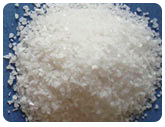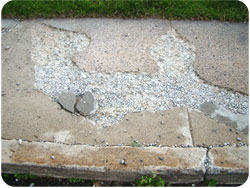
The use of Magnesium Chloride, also sometimes referred to as MAG, as an ice melter to melt the ice on concrete sidewalks, driveways or roads can be deadly. Why take the risk? MAG was once thought to be a safe and powerful ice melting solution. However, today there is much scientific information and evidence on the concrete damaging effects of magnesium chloride. XYNYTH Manufacturing Corp., a major North American manufacturer of ice melters, protects its customers by not using any magnesium chloride in its products, because of this overwhelming amount of scientific evidence.
The use of magnesium chloride will cause "scaling" of your concrete. Scaling, as defined by the American Concrete Institute (ACI 302) and the National Ready Mixed Concrete Association in their series of "Concrete In Practice," "is the local flaking or peeling of a finished surface of hardened concrete as a result of freezing and thawing.”
 The question always asked is: "so how does the magnesium chloride actually damage the concrete". According to Peter Snow, a concrete specialist from Burns Concrete in Idaho, the problem begins as the magnesium chloride comes into contact with the now deiced concrete surface and remains contained in the melt water, and permeates into the concrete. While deicing salts containing sodium, potassium and calcium are chemically innocuous to concrete, this is not true of magnesium. The magnesium ions accumulate and react with the cementitious compound calcium- silicate-hydrate converting it to magnesium-silicate-hydrate (or a mineral called brucite), which is non-cementitious in nature. In other words, a fundamental major mineralogical product of solidified concrete has now been chemically altered (completely changed). Formation of magnesium-silicatehydrate breaks down the “glue” that binds aggregates together and concrete surfaces begin to deteriorate. The net effect is we now have a chemical and physical attack that concrete is not designed to withstand, nor be subjected to.
The question always asked is: "so how does the magnesium chloride actually damage the concrete". According to Peter Snow, a concrete specialist from Burns Concrete in Idaho, the problem begins as the magnesium chloride comes into contact with the now deiced concrete surface and remains contained in the melt water, and permeates into the concrete. While deicing salts containing sodium, potassium and calcium are chemically innocuous to concrete, this is not true of magnesium. The magnesium ions accumulate and react with the cementitious compound calcium- silicate-hydrate converting it to magnesium-silicate-hydrate (or a mineral called brucite), which is non-cementitious in nature. In other words, a fundamental major mineralogical product of solidified concrete has now been chemically altered (completely changed). Formation of magnesium-silicatehydrate breaks down the “glue” that binds aggregates together and concrete surfaces begin to deteriorate. The net effect is we now have a chemical and physical attack that concrete is not designed to withstand, nor be subjected to.
Studies, funded by the Iowa Department of Transportation DOT), have been undertaken by the Department of Geological and Atmospheric Sciences at the Iowa State University, concluded that magnesium chloride produced significant concrete crumbling, fracturing and proved to be the most deleterious. There experiments took several cores of actual road concrete and subjected them to the wet/dry freeze thaw cycles they would normally undergo in winter conditions. looked at different de-icers and found that magnesium chloride will actually decrease the service life of concretes.
Interestingly they also found calcium chloride to be the next most destructive salt that they tested, causing discoloration, crumbling and fracturing.
The Iowa Department of Transportation (DOT) has produced similar studies and reports showing similar results of the Iowa State University, that magnesium chloride on produces significant concrete crumbling.
If one takes a moment to check out all the references shown below, they will see much more scientific and empirical evidence illustrating the dangers of magnesium chloride. So the obvious question, even though magnesium chloride may be an inexpensive and powerful ice melter, why take the risk of using it on a concrete surface only to damage it and cause yourself great cost. Even worse the liability to the re-seller who sells the product knowing all the damage it will create.
There are ice melt products on the market today, like Mountain Organic Natural Icemelter or GroundWorks Natural Icemelter, just to name a couple, that an end-user can safely use on their concrete with no damaging side affects. So again, why take the risk.
In summary, it is strongly recommended by many to stay clear of Magnesium Chloride (MAG) based ice melters, or those blends that contain MAG.
Magnesium Chloride as a Road Deicer: A Critical Review
Peter G. Snow, FACI, Burns Concrete, Inc. Idaho Falls, Idaho
www.pcei.org/MagchlorideWhitePaper.pdf
1998 Transportation Conference Proceedings
PCC Pavement Deterioration and Expansive Mineral Growth
Hyomin Lee, Anita M. Cody, Robert D. Cody and Paul G. Spry
Department of Geological and Atmospheric Sciences, Iowa State University
www.ctre.iastate.edu/pubs/crossroads/71pcc.pdf
Iowa DOT HR-355, Final Report
The Role of Magnesium in Concrete Deterioration
Project Development Division of the Iowa Department of Transportation
The Iowa Highway Research Board
Department of Geological and Atmospheric Sciences, Iowa State University
www.operationsresearch.dot.state.ia.us/reports/reports_pdf/hr_and_tr/abstracts/hr355.pdf
Mid-Continent Transportation Symposium
Effects of Various Deicing Chemicals on Pavement Concrete Deterioration
Hyomin Lee, Robert D. Cody, Anita M. Cody, and Paul G. Spry
Department of Geological and Atmospheric Sciences, Iowa State University
www.ctre.iastate.edu/pubs/midcon/Lee.pdf
Semiseqicentennial Transportation Conference
Concrete Deterioration by Deicing Salts: An Experimental Study
Robert D. Cody, Anita M. Cody, Paul G. Spry and Guo-Lian Gan
Department of Geological and Atmospheric Sciences, Iowa State University
www.ctre.iastate.edu/pubs/semisesq/session1/cody/
Semiseqicentennial Transportation Conference
The Formation of Rims on Dolomite Aggregate in Iowa Concrete
Paul G. Spry, Guo-Lian Gan, Robert D. Cody and Anita M. Cody
Department of Geological and Atmospheric Sciences, Iowa State University
www.ctre.iastate.edu/PUBS/semisesq/session1/spry/index.htm
Iowa DOT HR-384, Final Report
Expansive Mineral Growth and Concrete Deterioration
The Iowa Highway Research Board
Department of Geological and Atmospheric Sciences, Iowa State University
Abstract www.operationsresearch.dot.state.ia.us/reports/reports_pdf/hr_and_tr/abstracts/hr384.pdf
Report
www.operationsresearch.dot.state.ia.us/reports/reports_pdf/hr_and_tr/reports/hr384.pdf
Handbook of Test Methods for Evaluating Chemical Deicers---SHRP-H-332
The Role Of Magnesium In Concrete Deterioration---Iowa DOT HR-355
The Economic Impact Of Magnesium Chloride Deicer On Concrete Bridge Decks: A Study For The Montana Department Of Transportation—Reid Crowther Consulting Inc., Seattle, WA. And Montana DOT, Bridge Bureau
Effects Of Various Deicing Chemicals On Pavement Concrete Deterioration---Mid-Continent Transportation Symposium Proceedings
Effects Of Salt Type On Concrete Scaling—American Concrete Institute, D. B. McDonald and W.F. Perenchio
Frost Action In Cement In The Presence Of Deicers—Cement and Concrete Research, Pergamon Press, Inc.—G. G. Litvan, National Research Council of Canada
Use Of Road Salt for Deicing—City Of Vancouver—R. Birch, Vancouver, B.C., Canada ACI 201.2R Report “Guide To Durable Concrete “---Reported By Committee 201 of The American Concrete Institute, Farmington Hills, MI
Concerns Over Magnesium Chloride Prompt Study—Associated Press---Steven K. Paulson
Concrete Corrosion, Concrete Protection---Chemical Publishing Co., New York, New York---Imre Biczok
Experimental Work to Develop a Model for Cement Borehole Plug Degradation at the WIPP Site---Sandia National Laboratories, Albuquerque, NM.---Charles R. Bryan and Yifeng Wang
Modes of Experimental Concrete Deterioration--- Environmental & Engineering Geoscience—Association of Engineering Geologists and the Geographical Society of America
Cement and Concrete Chemistry---H. F. W. Taylor 2nd Edition
Mechanism of the CaCl2 Attack on Portland Cement Concrete. Cement and Concrete Research, vol. 8, 1978, S. Chatterji
The Effects of Deicing Salt on Aggregate Durability. Transportation Research Record, Vol. 1031, 1985, W. Dubberke and V.J. Marks.
Rim Formation on Iowa Highway Concrete Dolomite Aggregate: The Effects of Dedolomitization Reactions. Environmental and Engineering Geoscience, 1996, in press. G.-L. Gan, P.G. Spry, R.D. Cody, and A.M. Cody.
The Effect of Deicing Chemicals on Reinforced Concrete. Transportation Research Record, Vol. 1157, 1988, A. Nedezdin, D.A. Mason, B. Malric, D.F. Lawless, and J.P. Dedosoff.
Proceedings of the 7th International Conference on the Concrete Alkali-Aggregate Reaction, Noyes, New Jersey, 1994, M.-S. Tang, Z. Liu, and S.-F. Han. Mechanism of Alkali-Carbonate Reaction.